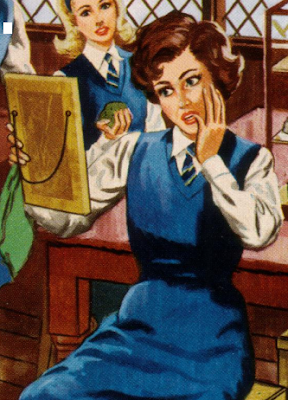From the late 1950s to the end of her career, art featured heavily in Jane Shaw's work. Looking After Thomas was about a daring art robbery at the Louvre. A painting by or thought to be by the French artist Maurice Utrillo was part of the plot of Crooks' Tour, The Picture and A Job for Susan. In the latter book, the Lyles' landlady is the grand-daughter of a respected artist and his work also features in the story. In other books, the characters visit galleries in Paris and Venice. Charlotte Carmichael is a gifted artist and ends up going to Perugia to study art professionally. So, paintings are definitely a major plot device in the works of Jane Shaw. She also wrote about an aspect of art that has been included in many children's books over the years: hidden paintings.
Many masterpieces have been found hidden under other paintings by impoverished artists wishing to economize on materials. For example, experts estimate that around one third of Van Gogh’s early paintings have hidden treasures underneath. More recently, lost masterpieces by N. C. Wyeth and Rembrandt have also been found. The hidden masterpiece, perhaps inevitably, due to her penchant for long-lost treasure, worked its way into two Jane Shaw stories: Susan and the Home-made Bomb and Susan’s Trying Term.
Many masterpieces have been found hidden under other paintings by impoverished artists wishing to economize on materials. For example, experts estimate that around one third of Van Gogh’s early paintings have hidden treasures underneath. More recently, lost masterpieces by N. C. Wyeth and Rembrandt have also been found. The hidden masterpiece, perhaps inevitably, due to her penchant for long-lost treasure, worked its way into two Jane Shaw stories: Susan and the Home-made Bomb and Susan’s Trying Term.
In Susan’s Trying
Term, when Susan, Midge and Tessa are cleaning out and reorganizing the school museum,
they come across an old painting of a hunting scene. Midge thinks the painting is
horrible because the horses’ legs are too long. But Susan thinks that if the picture
is cleaned up, it will look better. Therefore, she decides to "restore" it by wiping
it with a handkerchief soaked in turpentine. Lo and behold, the top layer of paint
is removed and another painting is partially revealed underneath. Midge and Tessa
are afraid that they might get into trouble for ruining the painting and suggest
that it should be dumped back into the cupboard where it was found so that it might remain forgotten by the school authorities. But Susan, with her characteristic honesty, insists that they have
to own up, and the girls take the painting to Miss Phillimore. The headmistress suspects
that it is a masterpiece by the 17th century Dutch artist Peter de Hooch. The painting
is given to Lady St. Ronan, who invites the girls to tea to thank them and announces
that the painting is worth twenty thousand pounds.
In Susan and the
Home-made Bomb, hard-up Jennifer Harding needs money to support herself while she studies
at the Sloane School of Art. Gabrielle Gascoigne says she can introduce Jennifer
to the director of the school and accompanies Susan and the Carmichaels to tea at
the Harding house. Peregrine goes along with them and plants his home-made bomb
in the drawing room. The bomb explodes and the explosion causes the lustres to shatter. A shard of glass streaks across a painting on the wall. Jennifer
thinks she sees another picture underneath. It turns out to be a Fra Angelico, worth
a small fortune. Jennifer can go to the Sloane and all the Hardings’ problems are
solved
The comic nature of these finds is obvious. Uncovering hidden paintings is an intricate and painstaking process that can only be done by experts. That a masterpiece could be found by wiping a painting with a turpentine-soaked rag is unbelievable. That a shard of flying glass could simply rip off the first coat of paint and unveil the one underneath without damaging either it or the canvas is even more incredible. These are further examples of the author's subtle sense of humour.
The comic nature of these finds is obvious. Uncovering hidden paintings is an intricate and painstaking process that can only be done by experts. That a masterpiece could be found by wiping a painting with a turpentine-soaked rag is unbelievable. That a shard of flying glass could simply rip off the first coat of paint and unveil the one underneath without damaging either it or the canvas is even more incredible. These are further examples of the author's subtle sense of humour.

No comments:
Post a Comment